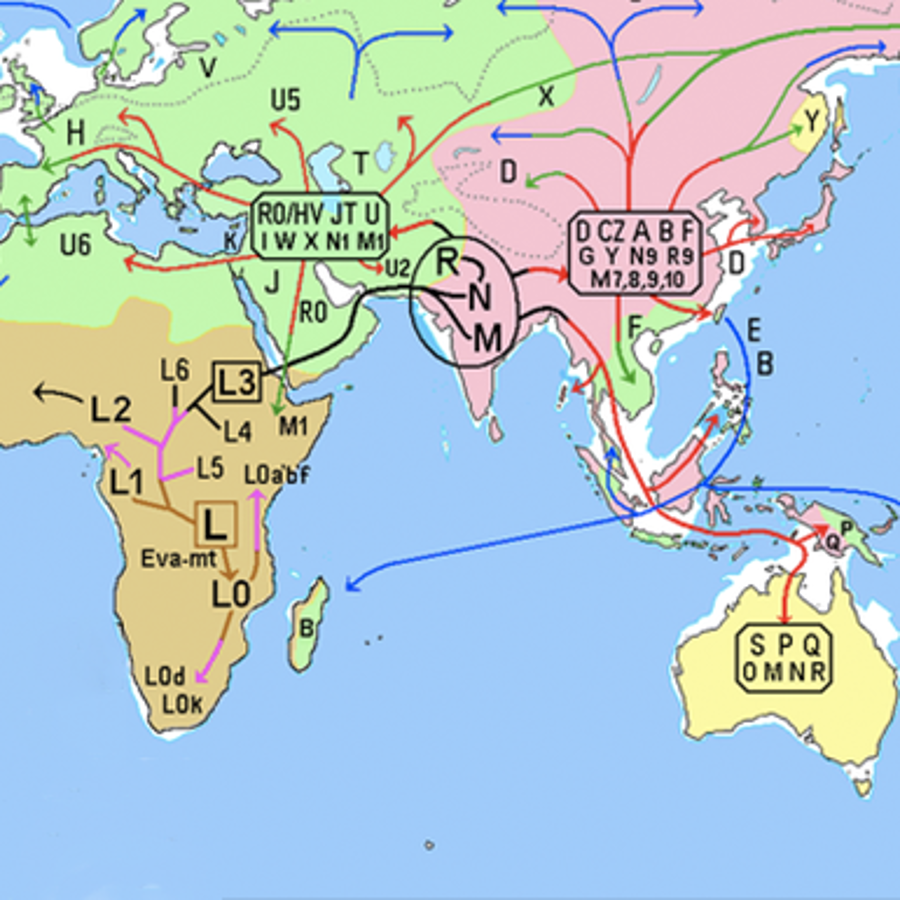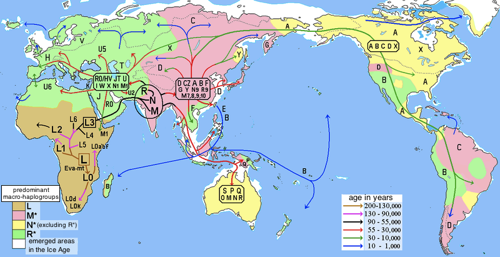
Is it possible to determine “race” through DNA analysis?
July 14, 2004

- Related Topics:
- Mitochondria,
- Ancestry
A curious adult from California asks:
"I have read, “Genetically speaking, nothing differentiates one race from another. All humans share the same set of genes. There is no African gene, no Caucasian gene, no Asian gene.” However, I also understand that there are genetic markers such as mtDNA haplotype L1, L2, L3, M, N and etc. that indicate a person’s origins. In light of this, isn’t it possible to determine “race” through DNA analysis?"
It is possible to identify a person’s likely ancestry through DNA analysis. But this isn’t the same thing as race.
At the gene level, people are much more the same than they are different. In fact, individual humans vary between each other much less than do individuals of almost any other species. All of this is because we came from a small group of common ancestors in the recent past.
None of this means that there are no distinguishing marks on our genes that can tell us where our ancestors are from. It is important to note, however, that these differences are incredibly minor. By and large, we are all very similar at the genetic level.
As an example, a tall white man and a tall black man probably have more in common genetically than do a tall and a short black man. This is because many more genes are probably involved in height than are in observable racial differences.
And two people from the “same race” can have different genetic ancestry. Just like two people who are from different races can have a similar genetic ancestry. Genetic analysis has shown that classic racial groupings are pretty arbitrary, and not based on biology.
Even though the differences between people are minor, they exist and so can be used to predict someone's ancestry from their DNA.
In fact, the FBI used a genetic test to figure out that a serial killer in Louisiana had mostly African ancestry. From that, they were able to predict he was probably black. Since they had initially assumed he was white (most serial killers are), this helped the FBI redirect their efforts and catch the serial killer.
So what differences did the FBI exploit? Some changes in skin color genes perhaps? No, they used differences observed in people's DNA outside of genes.
Only 3% or so of the human genome codes for genes. While the rest is sometimes called “junk” (unfairly!), it is really useful for tracing different people's origins. This is because DNA changes in these regions are much less likely to affect whether a person will survive or not and so can be passed on randomly. Isolated populations that start from a small number of people tend to share these changes.
The specific DNA scientists often use is not even found in the nucleus -- it is mitochondrial DNA (mtDNA). Mitochondria are organelles in a cell that provide energy. Surprisingly, they have their own DNA. (It is thought that 1 or 2 billion years ago, mitochondria were free living creatures that were eventually absorbed by our ancestors and now make our energy.)
The reason scientists use mtDNA is that it mutates fast enough that changes can be noted from our fairly recent past, and it passes from mother to children relatively intact. People can be grouped together based on when their ancestors migrated out of Africa thousands of years ago and where they went.
About 100,000 years ago, many Homo sapiens left Africa in a series of waves and settled Europe, Asia, Australia and the Americas. Since the migrations were small and happened in waves, each group's mtDNA is subtly different. For example, groups that stayed in Africa have a different set of changes in their mtDNA than did those that migrated to the Americas. This is where the haplotypes you mentioned come from.

All of this boils down to there are specific differences that can indicate where your ancestors are from.
But predicting ancestry is not the same thing as identifying race. The lines between groups are blurry, and ancestry often crosses classic racial groupings. Genetic analysis shows that “race” is pretty arbitrary, and not biological.
All in all, the differences between people are pretty minor when compared to other possible groupings like who will die young or get breast cancer or...

Author: Dr. D. Barry Starr
Barry served as The Tech Geneticist from 2002-2018. He founded Ask-a-Geneticist, answered thousands of questions submitted by people from all around the world, and oversaw and edited all articles published during his tenure. AAG is part of the Stanford at The Tech program, which brings Stanford scientists to The Tech to answer questions for this site, as well as to run science activities with visitors at The Tech Interactive in downtown San Jose.
 Skip Navigation
Skip Navigation
